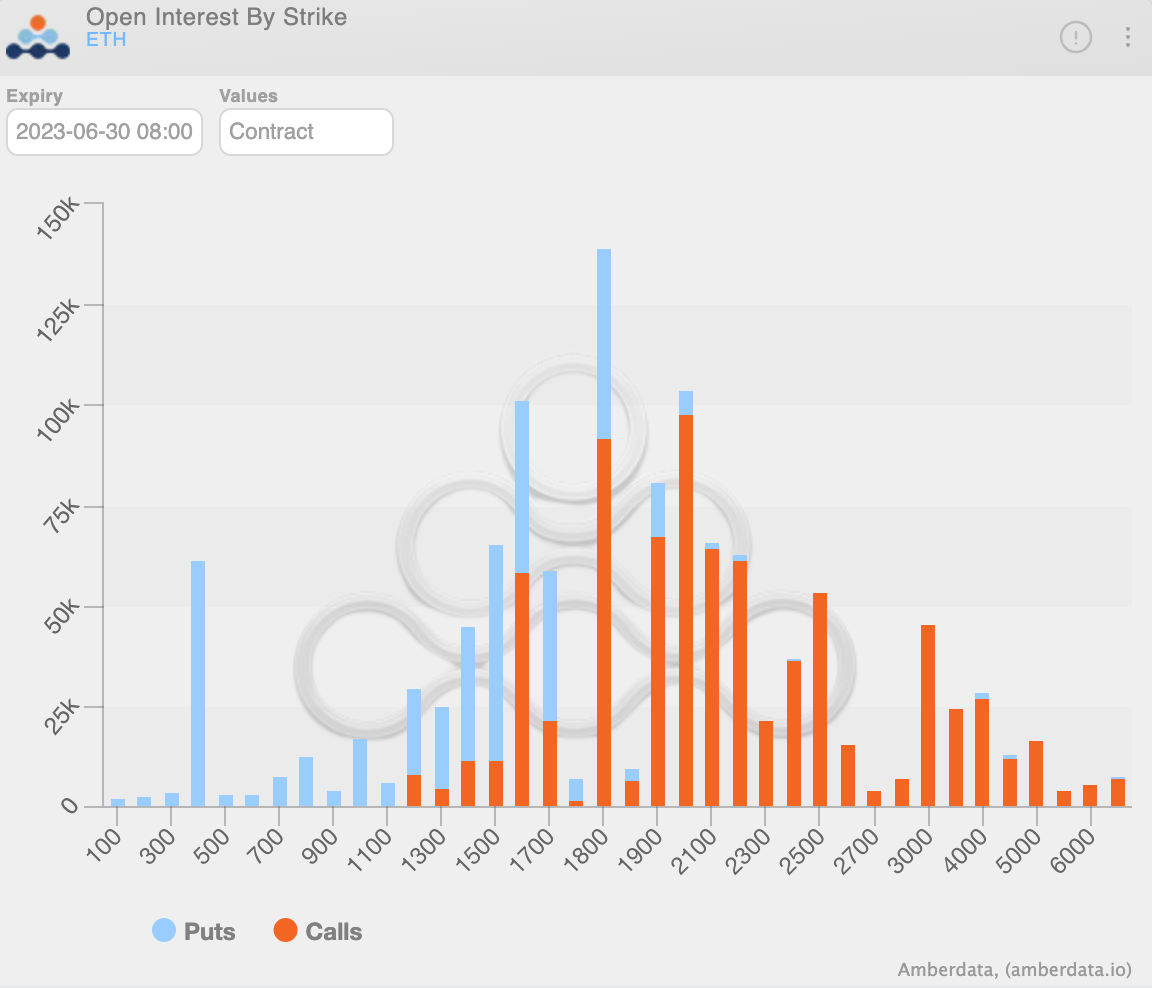Who Is The Mysterious Entity Impacting ETH Price?
What the ETH options market is saying

Three months ago, a historic shift began.
It’s similar to major oceanic undercurrents. These currents act like conveyor belts. They take warmer waters from the equator and push them to the poles. And then they bring cold water from the poles and drop them near the equator.
For anybody who has fished or lived near these areas around the equator, life is abundant.
The Galápagos Islands are case in point with over 9,000 species and new ones being discovered every year. The Humboldt Current, Panama Flow, and Cromwell Current all contribute to this real-world display of how important these currents are to healthy ecosystems.
When it comes to crypto, Shanghai became a new undercurrent to the market. Users were finally able to unstake their ETH. This was a major downtick in risk exposure, and as such, the amount of ETH staked quickly went parabolic, rising about 38% since.

This change resulted in a secondary effect in the market. I wasn’t aware of it until our friends from Paradigm reached out to say we might be interested in some insights they had to share.
Today, I and the Jarvis team as a whole look forward to sharing this bit of alpha with you, especially because it looks to become an ever-more important piece to consider in the changing landscape of prices in crypto.
Below, I’ll break down what we see going on with the assistance of Joe Kruy, Director of Institutional Coverage at Paradigm, who we enjoyed discussing this dynamic with.
The Real Reason Behind ETH’s Declining Volatility
With a quick snippet of background before we blast you with some big-brain quotes, you might recall a recent piece I (Ben Lilly) wrote on how volatility in the market was imminent.
Well, volatility hasn’t really changed a whole heck of a lot. In fact, it’s only gotten more subdued. Here is ETH’s volatility as measured by Deribit’s Volatility Index.

This compression in volatility is what we’ve all been watching in the market. As far as why, let’s bring in a few quotes from Paradigm’s Joe Kruy.
To start, Joe explains there is a noticeable entity making moves in the options market:
A large systematic overwriter who concluded 2022 with a bang by rolling 90,000 March $1,800 calls into June $1,800 calls, injecting about 125,000 net vega into a market starved of natural ETH upside buyers.
He then went on to add:
Paradigm flows suggest dealers to be considerably long the June $1,800 strike as a result of this overwrite, making dealers extend their vega and gamma on sell-offs, which induces a “spot down / volatility down” price action as they adjust their long volatility exposure towards this strike.
While some of you may understand what that means, I’ll go ahead and break this down…
When somebody sells a call option, they supply the market with a contract. The buyer of this contract is likely long the asset.
What the buyer is also long is volatility. The more that volatility rises, the higher the premium or value of the contract, all things equal – for the buyer. On the flip side, the seller is more profitable the lower the volatility.
Now, to measure your exposure to volatility, the options market uses a term called vega. It basically helps you understand how a 1% change in volatility impacts your contract.
What Joe is telling us is that somebody went ahead and sold 90,000 June call options. This put that person short volatility, or vega. And the fact that they were overwriting just means they were selling contracts whenever volatility started to rise. And this was just at the end of 2022.
But that was just the beginning…
There was also lots of this type of activity in Q1 and Q2 2023. To quote Joe:
Following the significant overwriting for the June / September contracts, the systematic seller unloaded ~40,000 vega clips in February and March via call calendar rolls (25,000-35,000 contracts). Post-Shanghai Fork, the quantities have significantly increased, led by a 63,000 June / September $2,200 call calendar sale, plus some additional September options sold, adding up to negative 200,000 net vega.
The backend volatility pressure continued with prints of 28,500 September / December $2,300 call calendars (negative 45,000 vega) and 10,000 June $1,800 / March $2,300 call calendars (negative 45,000 vega), further hammering 6-9 million volatility amid a lack of natural demand.
This is massive activity taking place in the Ethereum options market. And it’s a similar type of activity being seen over and over. As volatility begins to tick up, this entity begins to sell call options in mass.
Again, this is suppressing volatility. In fact, if price decided to run higher than whatever strikes (ie - $1,800 June contracts) were being sold, the original seller would need to hedge themselves.
And when this reverses, and this entity starts to unwind those positions, we get a bit of the opposite effect. According to Paradigm, at the end of last week this entity bought back 100,000 of the June contracts. Price reacted accordingly. This contract repurchased was covered by Paradigm on Friday via their Twitter handle @tradeparadigm.
While that was a large quantity, the impact to volatility was still rather muted, as there are still a lot of contracts outstanding You can see this in the bar chart below, which shows June 30 contracts by strike price. Note the amount of call options still opened at the $1,800 strike price in the tallest bar below.

This is rather fascinating behavior unfolding in ETH options. As Joe said,
Q2 has seen crypto option markets undergo significant microstructural shifts.
Which begs the question: Why is this suddenly taking place?
The Newest Market Current
Just as a changing ocean current can affect how an ecosystem functions, it appears Shanghai is already influencing activity involving Ethereum.
There is a belief that the upgrade is causing this entity’s behavior.
To go back to Paradigm:
Two factors can be partially attributed to this surge in ETH volatility supply: Ethereum's transition to a proof-of-stake model and the implementation of the Shanghai Fork. The Shanghai Fork, by introducing withdrawal flexibility, has prompted a significant rise in staking activities aimed at yield harvesting with validators.
Right at the end of that quote sits the main takeaway here. The entity in question is likely looking to extract additional yield from their staked ETH through this options strategy. Now that staked ETH can be withdrawn, they’re using their tokens as collateral.
These are monster positions they’re moving into. And if this type of activity goes wrong, it’s hard to say what might happen. But:
Collateralizing these trades necessitates substantial margin requirements, prompting us to question if this strategy is indeed the most efficient for extracting additional yield from ETH. We also speculate the possibility of a unique arrangement between the overwriter and Deribit to avert auto-liquidations, particularly during Q1's intense rally characterized by spot up / volatility up dynamics.
Remember, when you stake your ETH, you can’t unlock it right away. There is a bit of a wait time. Which is why a unique arrangement, as Joe alludes to, may be in place.
So, as to who might be the entity behind this new dynamic unfolding in the market:
While it remains purely speculative, given that these trades do not occur on Paradigm, it's possible that this considerable overwriter could be a large validator node. This could potentially explain their influence over the ETH volatility supply/demand imbalance, which has had a significant effect on the compression of both ETH's implied and realized volatilities…
To satiate my own curiosity, I wanted to see if this entity might exist onchain. Based upon the number of contracts at play, we can narrow down the honey pot of LSD, or liquid staking derivatives, to more than 250,000 ETH sitting in any one area onchain. That’s almost half a billion at $1,800 per token.
This gives us a starting point as it narrows the list of dozens of LSDs with enough size to a small list of stETH, cbETH, rETH, and frxETH.

Then, I looked where these tokens sat in bulk across yield aggregators, option platforms, vault strategy platforms, and swap pools. Nothing really caught my eye here. I was hoping to see a Ribbon Finance options vault with $100 million sitting in it, but what I saw was nowhere close in terms of significance.
Which means this entity might be one that has some operations not involving an onchain protocol.
Be that as it may, this is something to at least take note of as this entity is becoming increasingly important. The bigger they get, the more they impact price movements. And it also means the more severe they can be caught offsides.
We should also consider that their exposure to the upside is likely more than just spot ETH. The entity likely captures additional revenue from other operations as overall activity rises thanks to the positive feedback loop higher prices creates. Meaning this is more about grabbing revenue as the market crawls.
I’ll leave the fun in taking guesses to you all.
Hopefully we can learn the identity of this entity in time, for now, it’ll have to remain an unsolved mystery as nothing can be said with certainty.
I thank Joe Kruy from Paradigm for his time in blasting us with all this information that almost feels like insider alpha. Hopefully, we can have Joe back in the near future to give us some more insights on how the options market is impacting price. If you want to follow along their trade flow as they share it, you can join their Telegram channel.
Until next time…
Your Pulse on Crypto,
Ben Lilly





